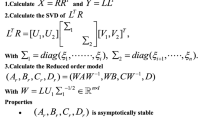Abstract
Two methods of balancing reduction are presented. The first is to truncate the states corresponding to smaller Hankel singular values of the reciprocal balanced system. The second is to choose one of some balancing methods, that has the least impulse response error by reducing one order at a time. The relation between the grammians of the balanced system and those of the reciprocal system is derived.
Similar content being viewed by others
References
Clapperton, B., Crusca, F. and Aldeen, M., 1994, “Bilinear Transformation and Generalized Singular Perturbation Model Reduction,”Proc. of the 33th Conference on Decision and Control. Lake Buena Vista, Florida, pp. 3737–3742.
Davidson, A. M., 1986, “Balanced Systems and Model Reduction,”Electronics Letters, Vol. 22, No. 10, pp. 531–532.
Fernando, K. and Nicholson, H., 1983, “Reciprocal Transformations in Balanced Model-Order Reduction,”IEE Proceedings, Vol. 130, Pt. D, No. 6, pp. 359–362.
Gawronski, W. and Williams, T., 1989, “Model Reduction for Flexible Space Structure,”AIAA Guidance, Navigation and Control Conf., pp. 1555–1565.
Hung, Y. S. and MacFarlane, A. G. J., 1982,Lecture Notes in Control and Information Sciences, Springer-Verlag, New York.
Hyland, D. C. and Bernstein, D. S., 1985, “The Optimal Projection Equations for Model Reduction and the Relationship Among the Methods of Wilson, Skelton and Moore,”IEEE Trans. Automatic Control, Vol. AC-30, No. 12, pp. 1201–1211.
Kabamba, P. T., 1985, “Balanced Gains and Their Significance forL 2 Model Reduction,”IEEE Trans. Automatic Control, Vol. AC-30, No. 7, pp. 690–693.
Laub, A. J., 1980, “Computation of Balancing Transformation,”Proc. 1980 JACC, San Francisco, CA, session FA8-E.
Moore, B. C., 1981, “Principal Component Analysis in Linear Systems: Controllability, Observability and Model Reduction,”IEEE Trans. Automatic Control, Vol. AC-26, No. 1, pp. 17–32.
Muscato, G. and Nunnari, G., 1994, “On the σ-Reciprocal System for Model Order Reduction,”Proc. of the 33th Conference on Decision and Control, Lake Buena Vista, Florida, pp. 3743–3745.
Ozcetin, H. K., Saberi, A. and Sannuti, P., 1989, “Special Coordinate Basis for Order Reduction of Linear Multivariable Systems,”Proc. of the 28th Conference on Decision and Control, Tampa, Florida, pp. 2418–2424.
Sreeram, V. and Agathoklis, P., 1989, “Model Reduction Using Balanced Realization with Improved Low Frequency Behavior,”Systems & Control Letters, Vol. 12, pp. 33–38.
Wilson, D.A. and Mishra, R.N., 1979, “Design of Low Order Estimator Using Reduced Models,”Int. J. Control, Vol. 29, No. 3, pp. 447–456.
Author information
Authors and Affiliations
Rights and permissions
About this article
Cite this article
Jeong, K.Y. Mixed balancing truncation for better impulse response. KSME Journal 10, 259–264 (1996). https://doi.org/10.1007/BF02942634
Received:
Issue Date:
DOI: https://doi.org/10.1007/BF02942634




